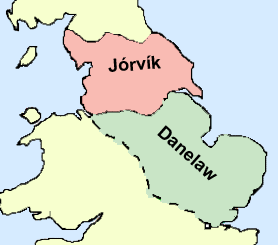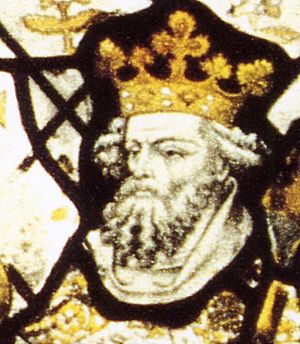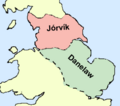Oslac of York facts for kids
Oslac was a powerful leader, known as an ealdorman (or earl), in York from about 963 to 975. His territory covered at least the southern part of Northumbria, a large region in northern England. We don't know much about where Oslac came from because old records are not very clear. This has led to historians having different ideas about his family and background.
Some historians think Oslac was the first ealdorman to rule only the southern part of Northumbria, rather than the whole region. However, other stories suggest Northumbria was divided after he left power. We don't know much about what he did as ealdorman, except for a famous story. This story says he helped the Scottish king, Kenneth II, visit the English royal court. Oslac was later forced to leave England in 975. After this, there are no records of his life. He had one son, but it's not clear if his son took over his position.
Contents
Who Was Oslac?
Oslac's early life and family are a bit of a mystery. We can't connect him directly to any other important people from that time.
What Does His Name Mean?
The name Oslac makes some historians think he might have been a Norseman, meaning someone from Scandinavia (like Vikings). The name Oslac is often an English version (an anglicisation) of the Old Scandinavian name Áslákr. Some experts also believe his name suggests he came from the Danelaw. This was an area in England where Viking laws and customs were very strong. The fact that his son, Thored, owned land in Cambridgeshire (which was part of the Danelaw) supports this idea.
However, Oslac is also a real English name. The first part of his name, "Os," is similar to the name of Osulf of Bamburgh. Osulf was an earlier ealdorman of York. This similarity might mean Oslac had a connection to the important Bamburgh family in the far north of England.
How Did Oslac Become Ealdorman?
Oslac's rise to power likely happened around 963. He signed three important documents as an earl in that year. These documents were about the northern Danelaw region. He probably became ealdorman after his predecessor, Osulf, died or was removed from power.
Some of these old documents are tricky for historians to use. They were copied much later, so there's a chance some information might have been changed. Also, another document from 966 shows Oslac as a "minister" (a lower-ranking official), not an ealdorman. This suggests he might not have become ealdorman of York until after 966. Some historians even believe Oslac became the most important ealdorman for all of Northumbria.
Northumbria's Division
An old text called De primo Saxonum adventu (which means "About the First Arrival of the Saxons") was written in the 11th or 12th century. It says that after Osulf died, Northumbria was split into two parts. Eadulf Evil-child supposedly received the lands between the Firth of Forth and the River Tees. Oslac, it claims, received the lands between the Humber Estuary and the Tees.
Another historian, John of Wallingford, wrote that King Edgar divided Northumbria during a meeting in York. He did this to stop one person from inheriting the entire region. However, another historical text, the Historia Regum, says this division happened during Osulf's time, not Oslac's. It also says the dividing line was the River Tyne, not the Tees. Historian Dorothy Whitelock thought this part of the story was likely not true.
Oslac's Time in Power
Oslac often signed official documents for King Edgar the Peaceable. This shows that Oslac was trusted by the king and held an important position at the royal court.
The text De primo Saxonum adventu also tells a story about Oslac. It says he, along with Eadulf of Bamburgh and Ælfsige, who was the Bishop of Chester-le-Street, escorted the Scottish king Kenneth II to King Edgar in Wessex. The story says:
The two earls [Oslac and Eadwulf] along with Ælfsige, who was bishop of St Cuthbert [968—990], conducted Cinaed to king Edgar. And when he had done homage to him, king Edgar gave him Lothian; and with great honour sent him back to his own.
If this event really happened, it must have been between 968 (when Ælfsige became bishop) and 975 (when King Edgar died). Historian Richard Fletcher believes it happened in 973.
Historian Geoffrey Barrow thought this event marked the beginning of Scottish control over the lands between the River Tweed and Firth of Forth (an area called "Lothian"). However, another historian, Alex Woolf, has suggested that the part about Lothian might have been added later. This could have been done to support the idea that Scottish kings owed loyalty to the English king for lands in Lothian.
Oslac's Downfall
In 975, not long after King Edgar died, Oslac was forced to leave England. The Anglo-Saxon Chronicle, an old record of events, doesn't say why he was banished. Version C of the Anglo-Saxon Chronicle describes it like this:
The valiant Oslac was driven from the country, over the tossing waves, the gannet's bath, the tumult of the waters, the homeland of the whale; a grey-haired man, wise and skilled in speech, he was bereft of his lands.
Historian Richard Fletcher thinks Oslac might have been banished because he opposed the new king, Edward the Martyr.
An old text called the Historia Eliensis says Oslac had a son named Thored. A man named Thored did indeed become Oslac's successor. However, historians are not sure if this was Oslac's son or a different Thored, the son of Gunner. Most historians lean towards the idea that the successor was Thored, son of Gunner.
The Gesta Herwardi is a story about a hero named Hereward the Wake. It claims that Oslac's great-great-granddaughter, Aedeva (also known as Edith), was Hereward's mother.
Images for kids





